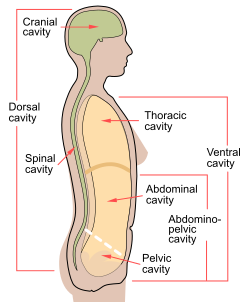Lesser pelvis
| Pelvic cavity | |
|---|---|
 |
|
| Details | |
| Lymph | Primarily internal iliac lymph nodes |
| Identifiers | |
| Latin | Cavitas pelvis |
| TA |
A01.1.00.052 A10.1.00.002 |
| FMA | 9738 |
|
Anatomical terminology
[]
|
|
The pelvic cavity is a body cavity that is bounded by the bones of the pelvis. Its oblique roof is the pelvic inlet (the superior opening of the pelvis). Its lower boundary is the pelvic floor.
The pelvic cavity primarily contains reproductive organs, the urinary bladder, the pelvic colon, and the rectum. The rectum is placed at the back of the pelvis, in the curve of the sacrum and coccyx; the bladder is in front, behind the pubic symphysis. In the female, the uterus and vagina occupy the interval between these viscera. The pelvic cavity also contains major arteries, veins, muscles, and nerves. These structures have to work together in a little crowded space. They can be affected by many different diseases and by many drugs in many different ways. One part may impact upon another, for example constipation may overload the rectum and compress the urinary bladder, or childbirth might damage the pudendal nerves and later lead to anal weakness.
The pelvis has an anteroinferior, a posterior, and two lateral pelvic walls; and an inferior pelvic wall, also called the pelvic floor. The parietal peritoneum is attached here and to the abdominal wall.
The lesser pelvis (or "true pelvis") is the space enclosed by the pelvic girdle and below the pelvic brim: between the pelvic inlet and the pelvic floor. This cavity is a short, curved canal, deeper on its posterior than on its anterior wall. Some consider this region to be the entirety of the pelvic cavity. Others define the pelvic cavity as the larger space including the greater pelvis, just above the pelvic inlet.
...
Wikipedia
